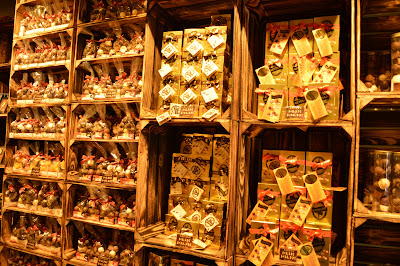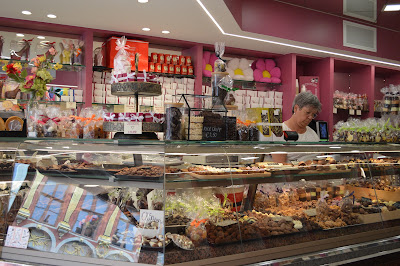I first heard about Bruges when I watched the 2008 film
In Bruges,
starring Colin Farrell and Brendan Gleeson. Set in the city it is not a
happy tale - betrayal and violence - but the architecture fascinated me.
Bruges, the capital of West Flanders in northwest Belgium,
is distinguished by its canals, cobbled streets and medieval buildings.
Its port, Zeebrugge, is an important center for fishing and European
trade.
A short history In the Bruges area, the first fortifications were built after Julius Caesar's conquest in the first century BC, to protect the coastal area against pirates. The Franks took over the whole region from the Gallo-Romans around the fourth century. The Viking incursions of the ninth century prompted reinforcement of the Roman fortifications.
 Bruges had a strategic location at the crossroads of the northern trade. Bruges was already included
in the circuit of the Flemish and French cloth fairs at the beginning
of the 13th century.
Bruges had a strategic location at the crossroads of the northern trade. Bruges was already included
in the circuit of the Flemish and French cloth fairs at the beginning
of the 13th century.
With the reawakening of town life in the 12th century, a wool market,
a weaving industry, and the cloth market all profited from the
shelter of city walls. The Bourse opened in 1309, most likely the first ever stock exchange. Such wealth gave rise to social upheavals, which were, for the
most part, harshly contained by the militia.
The first book in
English ever printed was published in Bruges by William Caxton, while
Edward IV and Richard III of England were then living their exiles in
the city.
During the 17th century, the lace industry took off, and various efforts to bring back the glorious past were made. During the 1650s, the city was the base for Charles II of England (his father Charles I was beheaded) and his court in exile. The maritime infrastructure was modernised, and new connections with
the sea were built, but without much success, as Antwerp became
increasingly dominant. Bruges became impoverished and gradually faded in
importance.
In World War I German forces occupied Bruges. However, the city
suffered virtually no damage, and was liberated on 19 October 1918 by
the Allies. The city was occupied by the Germans from 1940 during World
War II and was again spared destruction.
After 1965, the original medieval city experienced a
"renaissance". Restorations of residential and commercial structures,
historic monuments, and churches generated a surge in tourism and
economic activity in the downtown area. International tourism attracts some eight million tourists annually.
The port of Zeebrugge
was built in 1907. The Germans used the port of Zeebrugge for their
U-boats in World War I. It was greatly expanded in the 1970s and early
1980s
and has become one of Europe's most important and modern ports.
The medieval architecture in Bruges is mostly intact, making it one of
the best-preserved medieval towns in Europe. The "Historic Centre of
Bruges" has been a Unesco World Heritage Site since 2000.The heart of the city seems to be Markt Square (spelling is correct). I
would have loved to have taken a carriage ride around the city or a canl trip but they were beyond my resources.
The town hall is impressive and so is the Belfry. Bruges' best-known landmark is the 13th-century
Belfry of Bruges
which houses a municipal carillon comprising 47 bells.
Last time I will do that!
 I must have been feeling rebellious against my aging body as I agreed to climb up the entire belfry. It is so narrow
I must have been feeling rebellious against my aging body as I agreed to climb up the entire belfry. It is so narrow
and so steep I felt vertigo at times and it was pretty challenging to allow people to come down while we were trying to climb up and down the 366 steps. I overheard one young tourist say " I wouldn't want to do this aged 75". I chipped in and said, "well I'm 70". The reply was "you are very impressive then".
We stopped to
watch the carillon operating just after the hour. Musical compositions are still created
for it. It's very intricate and the mecanisms of metal pull wires
attached to all those bells which play in a proscribed order. Along the scarey climb you can see some exhibits on the lower sections - gates, trunks.
- gates, trunks.
Bruges
is known for its lace, a textile technique using bobbins and
embroidery.
My great, great grandmother made lace with bobbins in Akaroa
so I was pleased to see many examples of the differing techniques on
display in a lace shop. You can see some examples in the photo. One wall was devoted to 19th century lace - the real thing. It was too expensive for me to purchase, but I
loved learning and exploring within the shop.
Most of the lace is
produced in more rural areas of Belgium and sent to Bruges to be sold.
Bus links to the centre are frequent, though the railway station
is just a 10-minute walk from the main shopping streets and a 20-minute
walk from Markt Square.
Free public transport is available for those who park their cars in the main railway station car park.
The city is not car free but there are cyclists everywhere and it
all seems so natural there. There are acoutrements for all lifestyles;
you can add special paniers on the side or in front of your bike to
transport groceries or babies or tools of your trade - such a variety.
It must be bone-jarring on the cobble-stone sections though.
Watch out when walking the streets. The cyclists are silent and very fast. You won't hear them coming. Many cyclists do not wear helmets. The husband of our B&B host fell off his bike and is now in a coma in hospital. I don't know why helmet-wearing is not compulsory but at least half the cyclists don't bother to wear them.
And what about the Belgian chocolate?Err, um. Since I am (hopefully not permanently) prediabetic, chockkies were not really possible. How cruel! I did talk to one shop assistant who said she did have a few loose sugar-free chocolates so I bought 5 of them, ate 3 and gave the rest to my friends. Big purchase, eh?
There are chocolates and lollies everywhere and if you are into fresh waffles? I can't be, but you'll have no difficulty finding plain or stacked ones.

St Salvator's Cathedral
There's no getting away from churches and cathedrals while visiting european cities. This is another one. There were originally churches on this site but they evolved into what is a 101m long cathedral offically recognised as such in the nineteeth century.
There are several organs in differing styles from the heavy wooden ones to the bright stainless steel one. It's all quite baroque inside the cathedral.
 This cathedral is unusual in the fact that it has wall hangings/tapestries hanging up along the nave. I enjoy this sort of textile.
This cathedral is unusual in the fact that it has wall hangings/tapestries hanging up along the nave. I enjoy this sort of textile.
It is handy to have more than one language here. There's Flemish and French and Dutch. Luckily I speak French and English and many folks here speak a bit of both.
Bruges is most definitely worth a visit. Maybe a day and 2 nights is enough. Tack on a trip to Ghent and Brussels to complete the trio. The worst part of the driving was trying to nagivate past Paris - what a traffic jam horror. Pretty impossible to avoid it so take toll roads to get past it f you can. Once out of that you can take smaller roads for the scenic trip rather than motorways, your choice.


 Béville-le-Comte is a small village in the middle of La Beauce, a wheat-growing region of France located around the cathedral city of Chartres. This area is mostly flat for growing cereals, and stretches for many kilometres. So as soon as I was told this was the capital of the world for scarecrows I immediately looked at the fields expecting to see some. There were none. Not a one. Not even the black kites shaped liked crow that move in the wind. How disappointing! Even the village website does not explain how they could designate themselves as the scarecrow capital if I couldn't see them.
Béville-le-Comte is a small village in the middle of La Beauce, a wheat-growing region of France located around the cathedral city of Chartres. This area is mostly flat for growing cereals, and stretches for many kilometres. So as soon as I was told this was the capital of the world for scarecrows I immediately looked at the fields expecting to see some. There were none. Not a one. Not even the black kites shaped liked crow that move in the wind. How disappointing! Even the village website does not explain how they could designate themselves as the scarecrow capital if I couldn't see them. 






































.jpg)






